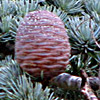Lebanon Cedar or Cedar of Lebanon (Cedrus libani), is a tall conifer tree in the Pinaceae family. It forms a wide spreading canopy. Its needles are silvery-blue, stiff and bent up to 3 cm long. Their cross section is quadrangular. They are arranged in clumps on short spurs. Young trees have a more greenish color and a pyramid shaped canopy. The mature trees are bluish and form a broad canopy with distinct horizontal branches
The male cones are pendular 5 mm thick and up to 5 cm long. The pollen is dispersed in the autumn by the wind. The female cones are erect barrel shaped light green when they are youg and turn brown as they mature at the age of one year.
The young branches a hairy. The trunk and branches bark is silvery and cracked. Propagation is by seeds.
Remnant of natural forests of Cedar of Lebanon can be found in the mountains of Lebanon, Syria and Turkey.
It is adapted to cold winters and has been introduced to gardening and forestry in temperate zones. It may reach height of 40 m at the proper conditions. It is drought tolerant and requires well drained soil condition. Propagation is by seeds. Ornamental cultivars may be propagated by grafting.
Cedar of Lebanon is one of only four species (not including cultivars) of true cedars. The others are Atlas cedar C. atlantica, Deodar cedar C. deodara and Cyprus cedar C. brevifolia. Most other "cedars" are of the Juniperus, Chamaecyparis, or Thuja genera.
The Lebanon Cedar is the national emblem of Lebanon, and is displayed on the Lebanese flag and Coat of Arms
Written by Amram Eshel




